It’s hard to imagine an omnipresent God dwelling in one place. And yet, every December we celebrate the fact. God dwells in the confines of a human body. And He is also everywhere.
But the incarnation isn’t the first time God has localized His presence among His people.
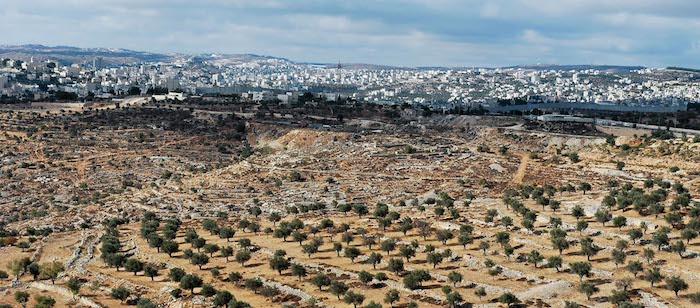
(Photo: Olive groves near Bethlehem. Courtesy of the Pictorial Library of Bible Lands)
God is both omnipresent and present. King Solomon summed up the seeming contradiction when he prayed:
Will God indeed dwell with mankind on the earth? Behold, heaven and the highest heaven cannot contain You; how much less this house which I have built. —2 Chronicles 6:18
From creation to Christmas—and from today to eternity.
Let’s take a quick geographical journey and follow movements of God’s dwelling place among us.
Walking in the Garden
They heard the sound of the LORD God walking in the garden in the cool of the day. —Gen. 3:8
The Lord created Adam and Eve in the Garden of Eden and enjoyed an unhindered relationship with them. The presence of God walking with them seems more than disciplinary, because they recognized Him. Adam and Eve hid from God after they sinned, because they knew the truth God confirmed when He sent them out of the Garden of Eden.
In fact, that truth was the problem the whole Bible is set on solving: God created us to be with Him, but sin can’t abide in the presence of God.
So He set His plan of redemption in motion, a plan to deal with the sin and to reconcile us to God. Why? Because God wants to dwell with us.
Wandering in the Wilderness
Let them construct a sanctuary for Me, that I may dwell among them. —Exod. 25:8
At Mt. Sinai, Israel constructed a tabernacle so that God could dwell among them, though His glory was hidden behind the tabernacle’s veil.
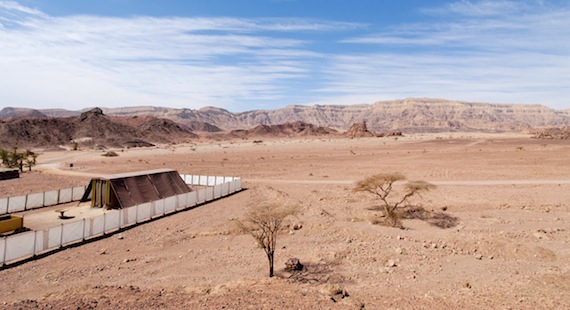
(Photo: Tabernacle model at Timna Park. Courtesy of the Pictorial Library of Bible Lands)
For 40 years in the wilderness, sin kept God’s people at a distance from the presence of God, which dwelt above the Ark of the Covenant inside the tabernacle. Once a year, the Day of Atonement would, in part, cleanse the tabernacle from the people’s impurities so God could continue to dwell among His people.
Wandering in the Promised Land
I have not dwelt in a house since the day that I brought up Israel to this day, but I have gone from tent to tent and from one dwelling place to another. —1 Chron. 17:5
After Israel entered the Promised Land, the tabernacle found a dwelling place at Shiloh for three centuries.
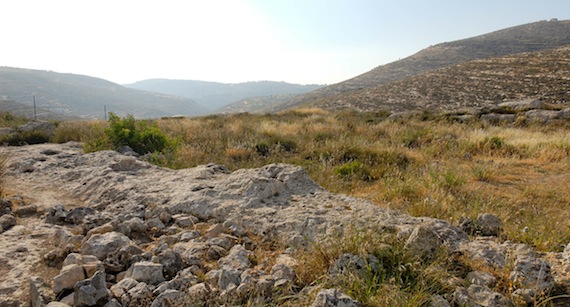
(Photo: Tel Shiloh, the area where the Tabernacle sat. Courtesy of the Pictorial Library of Bible Lands)
But after the battle of Aphek—in which the Philistines took the Ark of the Covenant and destroyed Shiloh (1 Sam. 4)—the presence of God (with the Ark) landed several places.
- The Philistines returned the Ark to Beth-Shemesh and—after the Hebrews foolishly peeked inside—the people sent the Ark to Kiriath-Jearim, where it stayed for about 100 years in “the house of Abinadab on the hill” (1 Sam. 7:1).
- The tabernacle and place of sacrifice to God were placed at the high place of Gibeon (1 Chron. 16:39; 21:29), which some identify as Nebi Samwil. (If anybody knows why the Ark was kept separate from the tabernacle, I’d love to know.)
- After one failed attempt, King David brought Ark up to Jerusalem to a tent he prepared for it (1 Chron. 13:1-14; 15:11-15).
Occupying (and Leaving) the First Temple
The glory of the LORD filled the house of the LORD. —1 Kings 8:11
King David’s vision to build a permanent house for the Lord found its fulfillment when King Solomon constructed the First Temple on the Temple Mount.
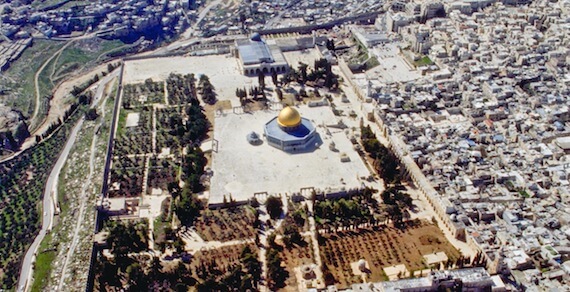
(Photo: the Temple Mount in Jerusalem. Courtesy of the Pictorial Library of Bible Lands)
But the sin of the nation divided Israel in two and ultimately resulted in exile from the Promised Land. The presence of God departed from the Temple (Ezekiel 10:18), and the Babylonians destroyed the temple and Jerusalem.
God’s prophets promised that God’s would again dwell with His people, but even they had no idea how marvelous this promise would be (Isaiah 7:14; Ezek. 37:27; Zech. 2:10).
Entering The Second Temple as a Man: God with Us
The Word became flesh, and [tabernacled] among us, and we saw His glory. —John 1:14
Although Herod the Great greatly enlarged the original Second Temple with a large retaining wall—the ruins of which still surround the Temple Mount today—Scripture never mentions the glory of God entering the Holy of Holies.
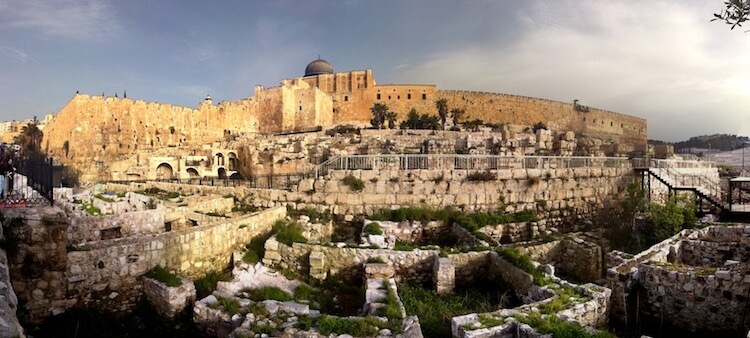
(Photo: Southern Excavations at the Temple Mount. Courtesy of the Pictorial Library of Bible Lands)
Instead, the glory of God entered another temple.
- Because John used the word “tabernacled,” he emphasized the glory that filled the wilderness tabernacle was now veiled behind the flesh of humanity (John 1:1; 14; Heb. 10:14-20)—as God became a man in Jesus Christ and paid for our sin by dying on the cross.
- Jesus entered the Second Temple, and used the “temple” as an illustration of His body that would be destroyed and raised up (John 2:19).
Notably, when Jesus died for our sins the veil in the Second Temple was torn in two from top to bottom (Mark 15:38). The separation our sin caused—Jesus removed.
Indwelling the Church
Do you not know that you are a temple of God and that the Spirit of God dwells in you? —1 Cor. 3:16
Before Jesus ascended after His resurrection, He promised to send the Holy Spirit who would indwell and empower His church to fulfill a great commission (John 14:15-17; Acts 1:8).
Jesus promised to be with His church always (Matt. 28:20). Ever since the Day of Pentecost in AD 33, the Spirit of God has indwelt each person who believes in Jesus. The Apostles Peter and Paul affirmed this amazing doctrine (Acts 11:16-17; 1 Cor. 6:19).
Tabernacling with People for Eternity
Behold, the tabernacle of God is among men, and He will dwell among them, and they shall be His people, and God Himself will be among them. —Rev. 21:3
In the eternal state, God promises that once again He will “tabernacle” with people. This fellowship—in a new heaven and a new earth—will occur as it did at God’s first creation, because there will be no sin to separate God and humanity.
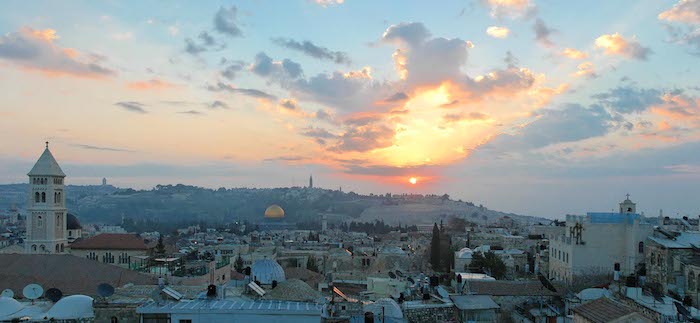
(Photo: Sunrise over Mount of Olives. Courtesy of the Pictorial Library of Bible Lands)
Jesus’ death for our sins makes it possible for us to be forgiven by God’s grace. When we believe in Jesus, we can come boldly into the presence of God both now and forever.
Tell me what you think: What aspect of the presence of God most interests you? To leave a comment, just click here.
